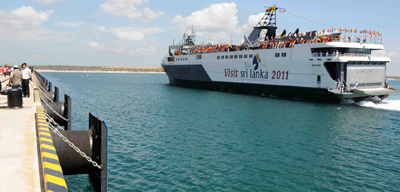The concept of a free port has once again entered into discussion among the Sri Lankan circles with the promulgation of an amendment to the Finance Act. What has been told is that the users of the port are free to use the port for loading, value additionand distribution without any taxes. The underlying theme is, as far as the port management is concerned, for the port users to operate without additional charges other than port handling and rent or lease charges.
One should not mix the two; namely, to have a free port with (only) port handling and rent or lease charges; and, secondly to have a designated Customs zone for value or process addition for entreport trade. While the second largely benefits the investor, it hardly adds anything to the operational expenses involved in port maintenance. Port maintenance is one aspect; while the Customs zone is another aspect. Taking a stock of all these cross purposes; can the gains from this intended Customs zone be of direct or indirect benefit to the maintenance and the debt payment of the port?
 |
| Hambantota Port |
Let us look at the history. For example, did a scheme like the Board of Investment (BOI) introduced during the open market economy directly benefit the development of the Colombo Port? If so, under what circumstances? The answer is that, though Sri Lanka opened its economy belatedly compared to Singapore, the country nevertheless benefited from operating as a hub for liner containers, especially after terminal construction projects of 1980s.
If one makes an assumption (only an assumption) that both developments of the BOI and the Colombo port are indirectly linked to the development of one another, leaving aside other contributing economic factors; there are still a few points to note here. First, it is a liner-container hub; the focus here is containers and not Ro-Ro vessels which brings vehicle shipments (for local consumption) like in the planned Hambantota port. Second, the first phase of the Hambantota port only resembles an industrial port in character and not a liner-container hub.
However the government has now taken a decision to develop Hambantota as a free port. Even assuming that what comes in goes out as re-exports, would the handling charges and other charges be go good enough to make good of the massive investment? An optimist would also say that this move will popularize the port, and once we complete (if we complete) the second phase, which is a container phase, Sri Lanka can get a headway into container operations.
The Hambantota port administrators’ plan is to allow the port users to operate without additional charges other than port handling and rent. If so they must also consider a number of important questions if public-private partnerships are reached: What changes in laws and regulations are needed to permit the private sector operations in the port?
How much management and operational autonomy will be given to the private sector? What will be the legal role of the port regulator in deciding the rates of private operators in the port? Who will be responsible for common user area maintenance/upgrades, and the cost of these activities be recovered from port users? All these factors must me weighted judiciously if the free port concept is to be successful.
(The writer is an
(Attorney-at-Law and
Chartered Shipbroker) |


